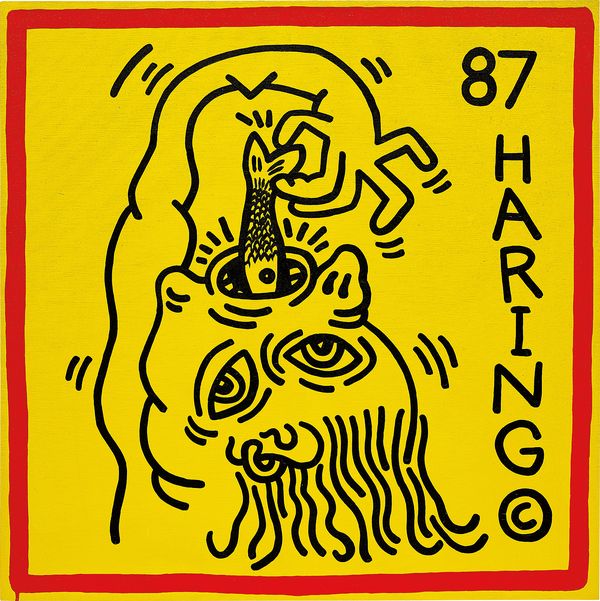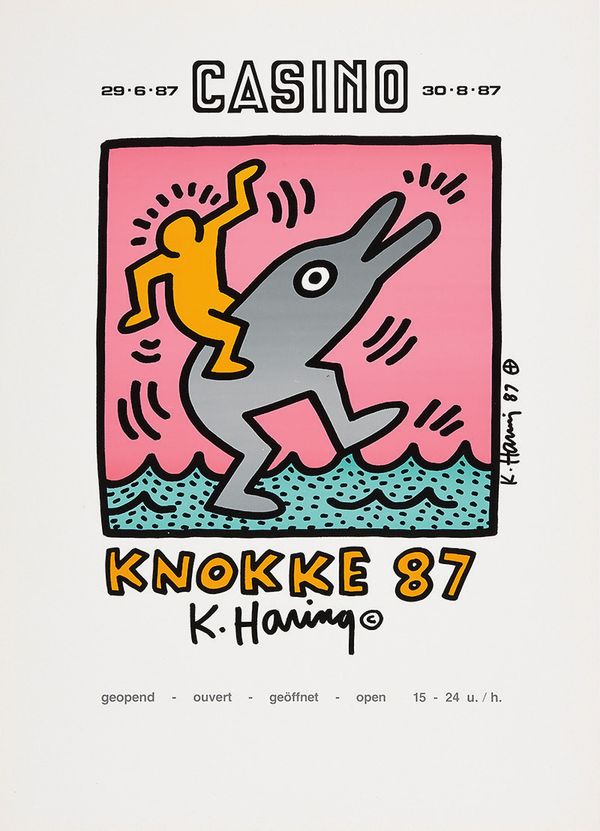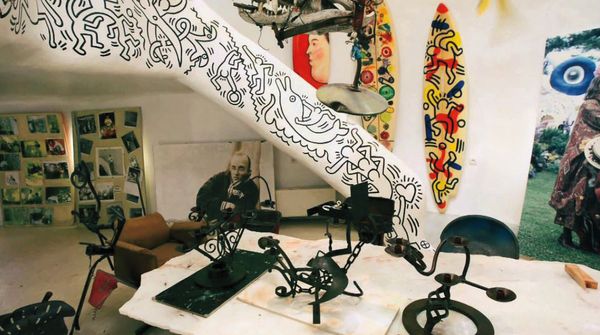Keith Haring's Mural at the Channel Surf Club, Knokke, 1987. © The Keith Haring Foundation, 2018.
For myself, I aim for an art which would be in immediate connection with daily life which could start from our daily life and which would be a very direct and very sincere expression of our real life and real moods.
— Keith Haring
Untitled (Knokke #3) is a rare but quintessential example of Keith Haring's distinctive style. Painted in Knokke in 1987, when the artist completed his monumental mural at the Channel Surf Club, this work from our 20th Century & Contemporary Art Evening Sale in London presents an open-mouthed, monstrous sea god ingesting a fish, whole. An ambiguous body of mythic significance is traced by Haring's signature line as it extends its distinctly human hand above its head. Singular and decisive brushstrokes dominate the work—a bold celebration of the artist's unique visual language.
By invitation of Roger Nellens in 1987, Haring traveled to Knokke in Belgium where he was commissioned to paint a mural. Nellens intended to continue the legacy of his father and brother who had also commissioned René Magritte and Paul Delvaux, respectively. While there, Haring found the side of a large sea container that stored surfboards for the Channel Surf Club. Painted in a single day, with two pots of black and red paint, Haring completed a scene that witnessed swimmers riding the crashing tides, advancing towards the mouth of a monstrous sea god that will surely consume them. Haring's spirited synthesis of mythic and human figures is echoed in this featured lot. The body appears as a kind of mortal and fabled hybrid, an uncanny creature that veers between the mythic-not-quite-human and the fragility of the mortal. Its human and non-human features reconfigure with every examination by the viewer, introducing a sense of movement to its gesture. The monstrous creature recalls those that dwell in the margins of medieval manuscripts or adorn the columns of the period's cathedrals, while also suggestive of the colossal sculpture of a dragon, Le Dragon by Niki de Saint Phalle, which Haring stayed in during his time in Knokke. This sculpture, a garden house built in Nellens' garden by de Saint Phalle, is a globular and vibrant structure which de Saint Phalle allowed Haring, Jean Tinguely and Nellens to graffiti from the inside.
The monstrous creature recalls those that dwell in the margins of medieval manuscripts or adorn the columns of the period's cathedrals.
Keith Haring Untitled (Knokke #3), 23 June 1987
Blocked out in graphic type to the right of the composition, Haring's name places his personality at the forefront of the work. Marking the work with the copyright symbol, directly below the capitalized rendering of his tag, the artist acknowledges the increasing popularity of his imagery with the proliferation of his visual language. On the appreciation of his trademark style and commenting on the reception of his Knokke mural, Haring remarks, as he was quoted in Journals, New York, 1996, "I begin Mural and immediately attract a crowd. By the time I finish, to applause, there are 50-60 people watching. The sun is really hot and I wear sunblock and a hat. The audience is incredible." While not site-specific like his monumental mural for the Channel Surf Club, the inscription 'KNOKKE' on the reverse of present work affords the canvas a singular site specificity. With Haring's signature style having permeated myriad public spaces, the present composition displays the artist's vibrant lexicon of motifs, transcending the limits of geography and time.
Painted in 1987, Untitled (Knokke #3) emerged at a time that witnessed an exciting and vivid revival of the oldest of artistic traditions: painting. Engaging with the medium Haring explores painting's historiography. Consistent with his prolific yet tragically short artistic career, the painting dynamically shifts between two aesthetic registers, the painterly quality of its medium and the pictorial syntax of a graphic typography. His minimalist use of line condenses his forms to their most rudimentary components, conjuring child-like drawings, ancient cave paintings as well as a basic street-style aesthetic. Haring established a singular and progressive pictorial lexicon, his forms and line recall the early cave paintings of Lascaux while simultaneously drawing upon Japanese, Chinese and Mayan pictograms, Egyptian hieroglyphics and Aztec or Aboriginal codes. According to Peter Halley, his work "looks ahead, to things like Japanese graphics and the importance of cartoons and comic books as a kind of universal populist language." Haring's recurrent employment of the body as the work's subject frames it within a historically significant linage of artistic preoccupation. His work advances toward a reconfiguration of painting as a language befitting the post-industrial landscape of 1980s America.
In Untitled (Knokke #3), mind and body engage in a kind of psychic automatism, a mode of artistic endeavor that recalls the work of Sol LeWitt and Cy Twombly. In drawing quickly, Haring's conscious mind is unable to filter cognition. Instead, his process allows his innermost thoughts to be given aesthetic form. The uncannily human Other that ingests the fish extends its arm, holding the fish above its mouth, completing a kind of circuit that is metonymic to the circle of life. The unconscious desire for immortality breaks through in this image.
I begin Mural and immediately attract a crowd. By the time I finish, to applause, there are 50-60 people watching...The audience is incredible.
— Keith Haring
Above from top: Invitation to Keith Haring exhibition at Casino, Knokke, 1987. Interior view of Nikki de Saint
Phalle's Le Dragon in Knokke with graffiti by Keith Haring. © The Keith Haring Foundation, 2018.
Mirroring Haring's epic mural at Knokke, Untitled (Knokke #3) makes a bid for immortality as Haring eternalizes the transition of life. Articulating his relationship with mortality which is brought to the fore in the painting, the artist states, "I am just a link in a chain." Here, Haring's mythical canvas stands as a lasting testament to the artist's singular pictorial register.
Instilled with Haring's pioneering dynamism, executed in the summer of 1987, Untitled (Knokke #3) is an engaging and otherworldly composition by the master of visual syntax.



